Artificial Intelligence (AI) is transforming industries around the world, and chances are, you’ve already tried tools like ChatGPT. You might have noticed that it’s a great tool for simple things but then again questioned how this is going to revolutionize my industry since it can’t automate my team’s work or solve complex tasks.
The current solution: prompt engineering
If you give AI more complex tasks to solve, for example: “Write me an article about [subject X]”, it most likely gives you a generic article which might look readable, but you could detect easily that it’s written by AI since it lacks unique insight, it has bias and contains rarely used grammar. You could improve the article by giving better definitions or prompts. The basic rule is that good prompts equal good results (1. IBM 2024). Prompt engineering has become its own kind of art or even a specialized job.
AI agents
Typically, you wouldn’t be happy with the first result so you would ask AI to improve certain parts of the text. This means that you need to iterate many times with AI tool which takes precious time. This is where AI agents take the stage. They are AI tools that are capable of autonomously performing tasks on behalf of a user or another system by designing its workflow and utilizing available tools (2. IBM 2024).
But how to take this even further? First, we need to consider how complex tasks are solved in the real world.

Pixabay
Multidisciplinary team in the AI world, multi-agent system
In the real world, complex tasks are ideally done by multidisciplinary teams where teams have enough different experience to solve problems they face. These teams regularly reflect on their progress, test ideas, and iterate multiple times on their solutions. That’s the idea behind the multi-agent systems (MAS).
Each agent within a MAS has individual properties but all agents behave collaboratively to lead to desired global properties. Multiagent systems are valuable in completing large-scale, complex tasks that can encompass hundreds, if not thousands, of agents (3. IBM 2024).
Let’s go back to the example of writing an article. In multi-agentic workflow the AI has multiple different roles. In this case, there could be roles for writer, interviewer, reviewer, grammar checker and fact checker. With these different roles, an article is reviewed and iterated through a cycle until agents determine that the outcome meets the desired standard of quality.

(Generated by Dall-e, 2024)
Use cases for Multi-Agent systems
An extreme example use case for Multi-Agent System (MAS) is modeling a software company or software development team as a MAS. In this scenario, a person assigns task to the MAS, which can then leverage agents with different roles to collaboratively create software.
One interesting project to follow is MetaGPT, which has developed a Text-To-App MAS solution. MetaGPT builds microapps – applications designed for specific tasks or use cases. Examples include Facebook Messenger, the project management app Trello, and even Microsoft Word (Wodecki, 2024). However, the results are still limited to these microapps at this stage.
Here is an image from MetaGPT’s GitHub illustrating how a Software Company MAS could be structured:

(MetaGPT, 2024)
Current state of multi-agent systems
The idea of AI agents originates from the 1980s and 1990s (Kornev 2024) but they were mostly theoretical until the recent years. Now with the rise of generative AI, the need for AI agents and cross-functional teams of agents has arisen. Currently there are not many ready-to-use AI agent solutions and even fewer multi-agent solutions. As a result, AI companies are competing to develop AI agent tools or companies may need to create their own multi-agent teams tailored to their specific needs.
Mastering the use of multi-agent teams could provide a significant competitive edge over companies which don’t use AI at all or use it in more traditional ways. Therefore, next year could be the year of AI agents and multi-agent teams.

Pixabay
Sources:
- IBM. 2024. What is prompt engineering? Available at: https://www.ibm.com/topics/prompt-engineering (Accessed: 27.10.2024)
- IBM. 2024. What are AI agents? Available at: https://www.ibm.com/think/topics/ai-agents (Accessed: 27.10.2024)
- IBM. 2024. What is a multiagent system? Available at: https://www.ibm.com/think/topics/multiagent-system (Accessed: 27.10.2024)
- Wodecki, B. (2024). MetaGPT: Text-To-App AI Simplifies Web Dev. AI Business. Available at: https://aibusiness.com/nlp/metagpt-text-to-app-ai-simplifies-web-dev (Accessed: 30.10.2024)
- MetaGPT. 2024. MetaGPT: The Multi-Agent Framework. Available at: https://github.com/geekan/MetaGPT (Accessed: 30.10.2024)
- Kornev, D. (2024). Autonomous AI Agents: Origins (1986-2022). Global AI Leaders. Available at: https://www.globalaileaders.com/p/autonomous-ai-agents-origins-1986 (Accessed: 27.10.2024)
